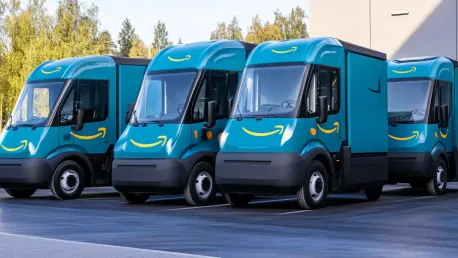Amazon has embarked on a transformative journey toward sustainability by committing $1 billion to electrify its European transportation network. This substantial investment is a vital part of Amazon’s broader Climate Pledge, which aims to achieve net-zero carbon emissions by 2040. This move signifies a deliberate effort to address Scope 3 emissions—those that originate from the supply chain and transportation activities, which constitute the majority of Amazon’s carbon footprint.
Major Acquisition of Electric Heavy Goods Vehicles
At the heart of Amazon’s strategy lies the purchase of over 200 electric heavy goods vehicles (eHGVs), the company’s largest single acquisition of electric trucks. Mercedes-Benz Trucks will supply the eActros 600 vehicles, which are scheduled for deployment along high-mileage routes in the UK and Germany. These trucks are projected to transport over 350 million packages annually, which will eradicate tailpipe emissions and considerably lower the carbon intensity of Amazon’s logistics operations. This massive fleet upgrade represents a significant leap in Amazon’s broader goal to diminish its environmental impact by transitioning to cleaner transportation solutions.
Andreas Marschner, Vice President of Amazon Worldwide Operations Sustainability, highlighted the significance of this undertaking, emphasizing that it sets Amazon on a leading path in electrifying heavy goods transport across Europe. This initiative is crucial for Amazon’s objective of achieving net-zero carbon emissions by 2040. Marschner underscored that these 200 electric trucks will pave the way for a more sustainable future in logistics, acting as a benchmark for other companies to emulate in their environmental strategies. The cumulative impact of utilizing eHGVs on such a scale cannot be understated, bringing Amazon closer to its lofty climate goals while showcasing the viability of large-scale electrification in the logistics sector.
Supporting Infrastructure for Electric Trucks
The implementation of these electric trucks necessitates robust supporting infrastructure, which Amazon is heavily investing in to ensure seamless operations. Amazon’s installation of 360kW chargers will play a pivotal role in maintaining the efficiency of its logistics network. These high-capacity chargers are capable of charging a 40-ton truck from 20% to 80% in just over an hour, thereby ensuring operational efficiency while diminishing emissions. By installing advanced charging infrastructure, Amazon sets a precedent for logistics companies to invest in similar technologies, thereby accelerating the shift toward cleaner transportation solutions.
A key aspect of Amazon’s environmental strategy has been the reduction of its carbon emissions, and 2023 marked notable progress. Specifically, Scope 2 emissions, which pertain to electricity usage, saw an 11% reduction, and Scope 3 emissions dropped by 5%. However, Scope 1 emissions, related to direct operations such as transportation fuel use, increased by 7%, reflecting Amazon’s expanding logistics network. This uptick underscores the essential need for transitioning to an electrified fleet to mitigate the growing environmental impact of its logistical operations. The development of a robust charging network is crucial to Amazon’s ability to meet its sustainability targets and address these increasing emissions effectively.
Addressing Scope 3 Emissions
Scope 3 emissions, making up 75% of Amazon’s total carbon footprint, are significantly addressed with the integration of eHGVs into its middle-mile network. Middle-mile logistics typically represent where one shipment is transferred between warehousing or distribution centers, often contributing to considerable carbon emissions. Amazon’s solution demonstrates a substantial environmental commitment, projecting that the reduction in emissions from these routes will significantly lower its overall carbon footprint. By addressing these critical areas, Amazon continues to advance its dual goals of environmental sustainability and efficient resource utilization.
Amazon’s strategy also encompasses leveraging rail networks and urban innovations such as on-foot deliveries and electric cargo bikes. For instance, since 2022, Amazon’s electric vans and cargo bikes in London have facilitated over 150 million zero-emission deliveries. This multi-faceted approach indicates Amazon’s commitment to minimizing its dependency on fossil fuels. Furthermore, the introduction of its carbon credit standard, named ABACUS, aims to tackle the shortage of quality-labeled offsets required to manage its residual emissions. This innovative approach to carbon offsetting enhances Amazon’s ability to meet its environmental targets while catalyzing broader industry adoption of rigorous carbon standards.
Overcoming Adoption Hurdles
Beyond electrifying its fleet, Amazon’s $1 billion investment also focuses on surmounting the primary hurdles hindering the widespread adoption of electric trucks. One key challenge is the scarcity of charging infrastructure that can cater to the demands of electric trucks. Amazon’s extensive efforts to build advanced charging stations and partnerships to enhance external networks align with governmental initiatives such as the UK’s $252 million Zero Emission HGV project, which aims at decarbonizing heavy transport vehicles in the country. These concerted efforts by both the public and private sectors signify an essential collaborative approach needed to advance the clean energy transition.
Lilian Greenwood, the UK’s Future of Roads Minister, commended Amazon’s efforts, acknowledging them as crucial steps toward reducing emissions within the logistics sector. By leading in the electrification of heavy goods transport, Amazon sets an example for others to follow, prompting systemic changes in logistics and supplier networks. Greenwood’s support highlights the critical role of governmental backing in encouraging private sector initiatives that aim to address climate change. Through this synergistic effort, the transition to sustainable logistics is rendered more achievable, reflecting a collective commitment to decarbonization.
Driving Innovations in Clean Energy
Amazon’s $2 billion Climate Pledge Fund further drives innovations in clean energy technologies, such as direct air capture systems and modular carbon removal solutions. This fund signifies Amazon’s commitment to pioneering transformative innovations that expedite decarbonization. In addition to these technological advancements, Amazon is actively engaging with its highest-emitting suppliers to prompt them to develop decarbonization strategies. This strategic engagement underlines Amazon’s proactive measures to catalyze industry-wide change, as it seeks to influence broader supply chain practices for enhanced sustainability.
Through the Amazon Sustainability Exchange, the company fosters collaboration, impacting broader supply chain sustainability. This platform serves as an important nexus for exchanging best practices, aligning efforts, and driving collective action toward net-zero goals. By investing in clean energy technologies and encouraging supplier accountability, Amazon extends its influence beyond internal operations to shape industry norms and standards. The extensive financial commitment and thought leadership exhibited through these initiatives underscore Amazon’s role as a vanguard in the clean energy transition.
Economic and Environmental Benefits
The electrification initiative is a cornerstone of Amazon’s approach to curb Scope 3 emissions and advance toward net-zero commitments. The adoption of electric trucks is anticipated to eliminate millions of metric tons of CO₂ from its logistics operations. To put this into context, a conventional freight gas-powered truck emits approximately 162 grams of CO₂ per ton-mile, resulting in significant emissions over extensive distances. For instance, a truck traveling 1,000 miles with a 20 short ton load would emit around 3.24 metric tons of CO₂. Thus, the shift to electric trucks will considerably mitigate such emissions, demonstrating a notable reduction in Amazon’s carbon footprint.
Amazon’s strategy also acknowledges the intrinsic economic benefits inherent in the clean energy transition. Investments in electric vehicles, renewable energy, and carbon-neutral technologies not only diminish environmental impact but also safeguard Amazon’s operations against future regulatory shifts and increased energy expenses. This strategic foresight helps the company stay ahead of regulatory changes and price fluctuations, ensuring operational resilience and sustainability. By integrating economic prudence with environmental stewardship, Amazon optimizes its efficiency and solidifies its commitment to long-term sustainability.
Industry-Wide Impact
Amazon has embarked on an ambitious journey toward sustainability, making waves with its $1 billion commitment to transform its European transportation network by electrifying it. This hefty investment is a crucial element of Amazon’s overarching Climate Pledge, a bold initiative aiming to attain net-zero carbon emissions by the year 2040. What makes this move particularly notable is its focus on Scope 3 emissions—those originating from the supply chain and transportation activities, which form the bulk of Amazon’s overall carbon footprint. By targeting these significant emission sources, Amazon is not only working to meet its ambitious climate goals but also setting an example for other corporations to follow on the path to sustainability. This initiative reflects Amazon’s deliberate and strategic effort to mitigate the environmental impact of its logistics and delivery operations, highlighting a commitment that extends beyond mere corporate responsibility to meaningful climate action.









